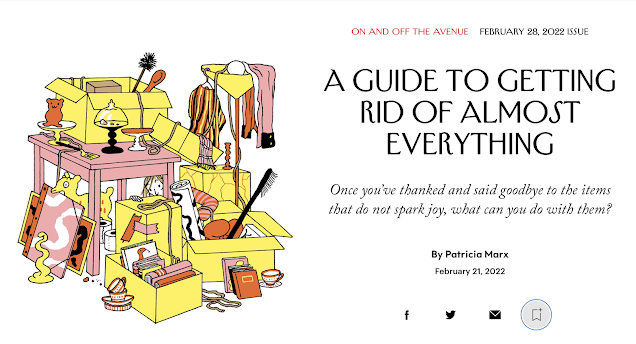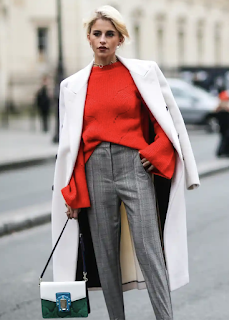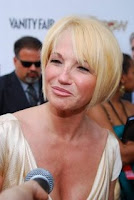Has the time come for the self-styled "work uniform?"
 | ||
| Photo: Harper's Bazaar.com |
Kahl commented that suit-wearing men have used this approach for ages, and tartly said, "...I couldn't help but notice that it appeared as if I needed a male authority to legitimize my choice of clothing in order for others to truly accept it."
Recently, she refreshed the pieces, ordering 15 identical white Zara shirts (at a discount). On weekends, she wears whatever she likes, including "lots of dresses".
I did a half-Melinda for awhile: in the early 2000s, when I worked for a global telecommunications company, I wore as the bottom part of an outfit only black pants or skirts. I found the formula liberating, professional yet simple. I wouldn't have had the nerve to wear but one full outfit, and am impressed by her resolve and equanimity.
Secretly, I've always been drawn to uniforms (and I admit, to men in uniforms; pilots, naval officers in dress whites. Now, where was I?) I spent my junior high and high school years in uniforms, and though we suffered itchy grey wool, I didn't envy my friends at other schools who waded through stacks of discards to find a different look, the right look, each day.
At only one other time was I issued a uniform of sorts, a lab coat, when I worked in hospitals in the 1970s. I liked the lab coat; it didn't much matter what you wore under it.
By 1980, I had moved to corporate life with its formal business attire: jacket-and-skirt, hose, heels—the whole kit on my dime, a steady drain on the paycheque for the next thirty-five years. I learned to enjoy the business-world fashion show, but by the 2000s, was disenchanted with the continual expense and upkeep. Hence, the black on the bottom gambit.
There was definitely competition in the corporation. One woman executive made it known that her female direct reports should buy their suits from a designer she favoured. (Men, I noticed, might compliment another man's new suit but no one sniped that Jim's blue pinstripe had been seen for several years.)
Many companies specify a dress code so that employees wear all but a uniform, but have some choice regarding fit or quality. Some retail apparel stores specify that staff wear only clothing sold there, and offer attractive discounts.
Kahl, though, marches to her own elegantly emphatic beat, and I love it! She reminds me of certain designers (Calvin Klein, Yves St. Laurent, Marc Jacobs before he went into kilts and kohl) who worked in austere, self-styled uniforms, such as jeans and a white shirt. In photos of Coco Chanel in her atelier, she's usually wearing her classic suit and brimmed hat, with low heels (like the classic Vivier) or flat-heeled boots.
This post was interrupted by my Canada Post carrier, in her regulation navy and red pants and parka, topped with a jaunty toque. She didn't have time to discuss her clothing, she's a working woman headed out in -12C/10F weather.
Have you ever worn a uniform? Would you welcome its comfort and constancy, or find that a dispiriting way to face the world?





Comments
More recently, I feel into a retirement uniform this fall and have much enjoyed it, although I seem to be coming out of it a bit with spring's beckoning. Jeans, a sweater, often in neutral tones, often cashmere, Blundstones or oxfords, my pea coat, and a camel-coloured cashmere woven scarf. So calming, somehow....
a scarf or necklace are my uniform. It just saves so much time and frees up my brain cells for other activities.
In retirement, I wear my uniform of sweater & pants in winter and linen shirt & pants in summer plus scarves and jewellery. So easy and freeing. Currently I'm experimenting with tights and dresses to ring some changes.
There was an obvious hierarchy being reinforced by how much choice we were allowed in our work attire. Nurses, physical therapists, and respiratory therapists all had to wear hospital provided uniforms in different colors depending on their title. So did housekeeping and dietary staff. Doctors, on the other hand, wore whatever they wanted. Even though they, too, were involved in direct, hands-on patient care, their higher status gave them complete autonomy in what to wear. Social workers and dietitians were treated like doctors and allowed to wear street clothing. I have no idea WHY. My nursing manager wore street clothes and a long white coat issued by the hospital, similar to what the attending physicians wore.
It was certainly easy (and cheap) to wear the hospital provided scrubs, but I missed getting to pick out my own uniform. But it wasn't until the hospital started providing SCRIPTS to the nursing staff that I began to understand where they were going with this. There was a correct way to answer the telephone, complete with a greeting and a closing. We had a script to follow for when we entered a patient's room and another one to recite before we left the patient. Once the behavioral audits started where we were forced to follow our fellow workers into rooms and make sure they were staying on script, it wasn't long before I took early retirement.
I wish they'd decided to to go back to the old dress code of nurses wearing white from head to toe. It looked clean. It looked professional. And no one confused you with one of the housekeeping staff.
At least I didn't need to buy new clothes for retirement. I worked three 12 hour shifts per week so I already had a wardrobe for the other four days of the week.
Mme: I've had many primary-school teacher friends over the years and they keep saying the clothes have to be washable, and they like colour; some feel it signals warmth and approachability. My high school teacher friends wore "business casual" attire and many schools had a dress code for teachers.
Murphy: Does anyone remark on your 'uniform'? Are others there doing that, too? I used to get teased, "Oh, is that a new...black skirt?"
Louise: Sounds ideal, to have that personal touch.
Wendelah: Thanks for the peek at the culture in your hospitals. I well remember the full nurse's dress, with the cap that signaled her (they were 99% women) school, and the stripe for grads. Some of those nurses looked very sexy because you could wear those uniforms tight! Then came the shift to scrubs or pants with tunics. (Funny how the tunics had to cover the butt but the dress uniform did not!) I also worked with nurses who were nuns, and who wore a version of their habit, first full-length, then knee. They never adopted the tunic pantsuit.
There were minor status signifiers- who got to wear a stethoscope, as I recall. Anyone visiting the floor (e.g., MDs, RTs, infection control officers, chaplains) was required to wear a lab coat; the surgeons often wore scrubs. No one could wear street clothes. The signifier was the name badge, which was coloured by occupation.
Working at conferences abroad, I quickly adopted uniform: always a black skirt (with leggings or tights; I don't work in as "straight" a field as corporate ones) or trousers and some kind of jacket over a top; mostly black clothing though I do have some colour in tops and scarves. One thing I hated in some jobs was having to wear sheer stockings that ladder immediately; nowadays bare legs have become more acceptable in many work settings, in the summer.
It's my intention to also wear a charcoal skirt (ooh, edgy!) from time to time but realistically, I never do.
I do wear a uniform of sorts now that i have retired...pants or jeans, a tee and a sweater unless I am going out and then I add a scarf or swap the pants for a skirt or dress...most of my clothes are black, grey and whites...
Any woman who travels for work learns to collect scarves, even if she didn't before!
My closet is not overwhelming, my morning is streamlined, and no one seems to have noticed I'm wearing the same five things because I mix up what I pair. It's perfect.
Uh oh, now I am thinking about pilots again ;)
I'm especially intrigued by her one, unchanging piece of "jewelry," the leather tie. This whole discussion brings back good memories of the "plus strict" discussions here a while back.
I went to public school, and did long for a uniform from time to time. I'm very, very drawn to trying this -- what's the worst that could happen?
Most of this evolved because I kept narrowing down what I chose to wear from a larger selection. The white blouses were too "bright", the other colors of slacks were too "loud", the other sweaters that had prints or fancy features were too "busy" - they have disappeared. The pinstripe shirts match anything yet give a bit of interest over plain white, so I settled on that and now don't buy any other type.
My summer "uniform" consists of slip-on flats, gray or black pencil skirts and print "silky" blouses, either with out without sleeves. Then I can add a colorful cardigan if the weather dictates.
Perhaps the more flexible approach, you with your dresses, others with neutral trousers and jackets, is a happy medium.
What the authors (Olivia Goldsmith, Amy Fine Collins) really meant is that •Getting• to Simple Isn't Easy. Among other steps you have to divest a lot of mistakes, and learn what's best on you. I've listed the principles in this post:
http://passagedesperles.blogspot.ca/2011/06/simple-isnt-easy.html
babette: You and I were alike in that the bottom half varied little, and the top
changed. (But it took me years of bulging closets and equally bulging Visa bills to figure that out.) Kahl went beyond our simplified wardrobes: the same clothes and accessory every day, only adding or leaving off her black jacket. Not red, not navy... only that same black jacket. I think that takes fortitude, and I wonder if she will keep it up.
Sisty: You'll see from the comments that many of us have edged to a variant of a uniform, maybe not as purely as Kahl, but with a preference for only slightly varying ensembles. Yes, Kahl's suit is 'strict': discreet clothing characterized by clean lines that follow the body without being either too tight or loose, no pattern, and the whole outfit unrelieved by that "pop of colour" some women feel they must have. It is a lightly androgynous look leavened by her long, tumbling hair.
Love my job.
s.: Oh, you old girl... I know where!
KPD: You remind me of the primary school principal who once said to me, "The difference between your job and mine is, when I'm having a rough day I can walk onto a playground and get twenty hugs."